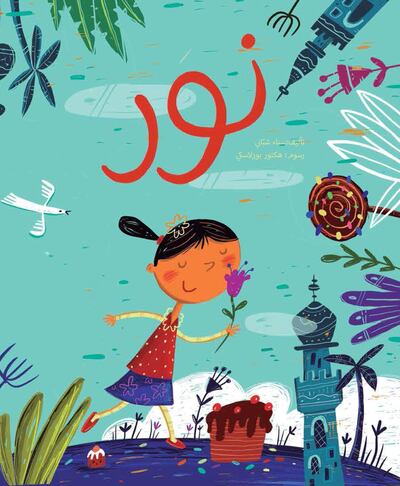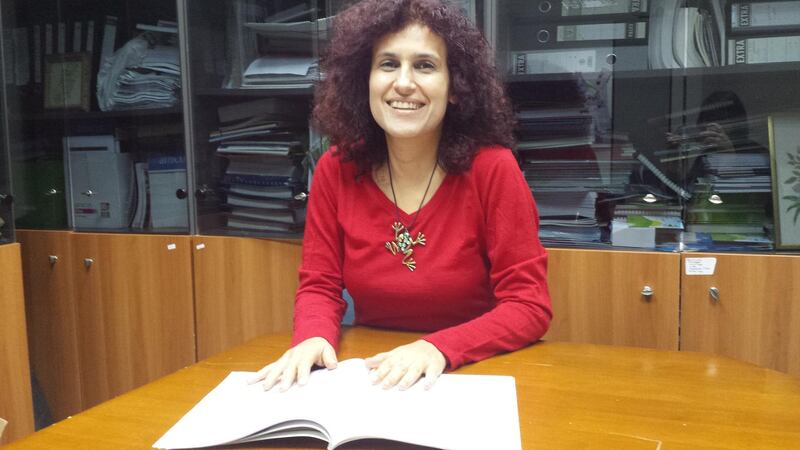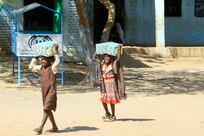Noor begins with a party. The titular character of the children's book has done well in school and her family is celebrating her success. The smell of a freshly baked cake wafts from the kitchen. There are sounds of balloons inflating in the living room and of cutlery being laid out on the table.
Readers of the illustrated Arabic book will not immediately realise that young Noor is visually impaired. They will follow her as she uses her other heightened senses to learn and enjoy everything going on around her. Her condition will become gradually apparent to readers as she receives a number of presents from her family: a cat she's always wanted, a flower she can identify by its fragrance and a book in braille.
"I have always wondered what it would be like to lack one of the five senses; how differently I would then perceive the world," Noor's author Sanaa Chabbani tells The National.

The Lebanese writer – who also works at the University of Balamand’s Faculty of Health Sciences, producing educational materials and implementing community development projects – says that children with disabilities often adapt differently from those who are gifted with all five senses.
“Studies have proved that four functioning senses of blind and visually impaired [people] are heightened to navigate their environment,” she says. “For instance, they develop their own visualisations and markers for what is around them by applying their heightened sense of smell, touch and hearing.”
In Chabbani's book, Noor's parents, her brother and sister come together to support the young protagonist. Each one has a unique impact in helping her learn and adapt to her surroundings.
It is clear that Noor derives her strength and positivity from her loving family. The story hints that her parents might be under financial duress and the little girl understands the challenges they face to meet the needs of the family.
“There are a number of social barriers that impact a family who has a child with a developmental disability, hearing problem, or visual impairment,” Chabbani says.
“The first barrier usually is encountered within the family – a lot depends on how families respond to the question of acceptance and how well they embrace their child’s disability. The second barrier is financial – whether or not families can afford the high costs of medical care and related care amenities. More broadly, the way national policies are structured and how strong the culture of inclusion in society are, will determine the child’s future.”
Chabbani wrote this story to convey the difference love can make, both for the child with a disability and the family. She says that parents who are strong and loving give their child a healthy upbringing and create a safer and happier life for them.
“This was my overarching premise for Noor's character development. Once I had fully developed her, the rest of the story evolved organically,” Chabbani says.
But writing Noor did not come without challenges. As the story was aimed towards a young audience, the author had to be mindful of how to present a number of complex ideas as simply as possible, using short sentences and expressions that are easy to read and understand.
“Some of the challenges were how to express all the emotions of a girl with visual impairment. How could I describe the main character the way she deserved to be? I wanted to portray Noor as someone filled with enthusiasm, love, emotions, gratitude, excitement and satisfaction. It took me two months to find the right words that despite their simplicity, would trigger the right emotions in the reader.”
Noor's publisher, Kalimat – an imprint of the Sharjah-based Kalimat Group – wanted Chabbani's writing to be accompanied by illustrations that would add a layer of meaning and reveal the hidden emotions in the story.
Argentinian illustrator Hector Borlasca – who has worked on more than a dozen children’s books in English, Spanish and Arabic – was selected for the job. Chabbani says he “was just right for the book”, even though the two had never met.
“When I saw the samples, I felt so happy,” she says. “[Borlasca] was able to convey the meaning of each sentence through his illustration. I felt this harmony existed in our thoughts even without knowing each other.”
Published in September 2019, Noor is different from Chabbani's other works, mainly because it is the first time she has set out to write a book with a visually impaired protagonist. However, Noor and her other stories, all of which have been published by Kalimat, do have one message in common.
"The works all relay how important it is to empower young girls," the author says. "How necessary it is for them to have access to education and to develop a scientific mind to help them face life's challenges. To have the self-confidence to dream high and enjoy the company of family, friends, and care for nature."








